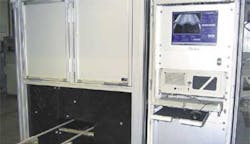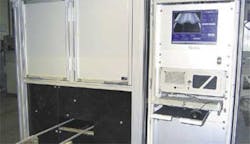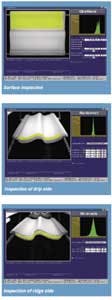Roof tiles inspected with sound and vision
Andrew Wilson, Editor
Although the humble roof tile may not appear to be the most sophisticated of products, to produce tiles of a consistent quality, manufacturers must ensure that their production lines employ the latest in inspection technology.
In the tile manufacturing process, clay sheets are extruded from a clay mixture and cut and formed into shape in a press. They are then fired in a kiln, coated and dried. Prior to collating the tiles and packing them for shipment, however, the tiles must be inspected to detect failures like fractured edges, cracks, inclusions, bumps, surface defects, deformation, and any color aberrations.
To help them with the task, engineers at ibea (Hamburg, Germany; www.ibea.de) have developed a vision-based system that enables such tiles to be inspected at a rate of 150 per minute (Figure 1).
To do so, the tiles are carried along a conveyor into ibea's dome-shaped vision station. Inside the station, a pair of high power LED lighting banks mounted on either side of the conveyor project light onto the top surface of the dome, illuminating the top surface and sides of the tiles with a diffuse light (Figure 2).
Four 1.4Gpixel ace cameras from Basler (Ahrensburg, Germany; www.baslerweb.com) capture images of each tile as it moves through the inspection station. A camera mounted on one side of the station captures images of its so-called ridge side, while a camera on the other captures an image of its drip side. When laid on a roof, the ridge side of a tile points to the top of the building, while the drip side points to the ground.
Due to the specular reflectance of light from the polished surface of the tile, the use of a single camera would be insufficient to capture a perfect image of its surface. To circumvent the problem, the system uses two Basler 1.4Gpixel cameras mounted a specific distance apart in the roof of the dome which point down at the tiles at an angle.
The cameras both capture a full image of the surface of the tile. However, because of the limited depth of field of the cameras, each one is only able to capture acceptably sharp images of one half of the surface of the tile. Hence the two images from the cameras are stitched together to form a complete image of the tile surface prior to being processed by the image processing software in the system.
To check the dimensional accuracy of the tiles, the system also uses a triangulation based laser scanner that captures a 3D map of the tile so that its dimensions can be evaluated. The laser scanner system itself comprises a laser light source from Z-laser (Freiburg, Germany; www.z-laser.com) that illuminates the top of the tile as it passes through the inspection station and an Automation Technology (Bad Oldesloe, Germany; www.automationtechnology.de) 1280 x 1024 AT C4-1280-GIGE line scan camera that captures the images of the light transmitted by the tile.
Data from the four Basler ace cameras and the line scan camera are transferred over a GigE interface to a PC where the images are processed by ibea's custom software running under Linux. There, the data from the 2D cameras are processed to detect texture defects, flaking, cracking and any color issues with the tiles (Figure 3). The 3D images captured by the line scan camera are also processed to enable the length, width, and height of the tiles to be measured to within an accuracy of 0.1mm, enabling any unevenness or distortion to be detected.
To complement its vision inspection system, ibea has also developed an acoustic inspection system that detects cooling cracks and internal cracks in the tiles prior to the vision inspection process. The acoustic system hammers each tile as it passes through the inspection station at precisely the same spot each time. The acoustic tone of each struck tile is recorded by a directional microphone. The quality of each tile is then determined by comparing the acoustic signature of the tile with one from a good known tile.
Aside from its use detecting flaws in tiles after they have been fired, coated and dried, a similar ibea vision system can be used earlier in the production stage to determine the quality of the tiles prior to firing. Here, however, only a single camera is needed to image the top surface of the tiles due to the fact that the unfired, uncoated tiles are not as specularly reflective.
Using the vision system at this earlier stage of the production process, manufacturers can be assured that only tiles of sufficient quality will be fired, enabling them to reject faulty products earlier in the production process and save energy costs.
Vision Systems Articles Archives
About the Author

Andy Wilson
Founding Editor
Founding editor of Vision Systems Design. Industry authority and author of thousands of technical articles on image processing, machine vision, and computer science.
B.Sc., Warwick University
Tel: 603-891-9115
Fax: 603-891-9297



